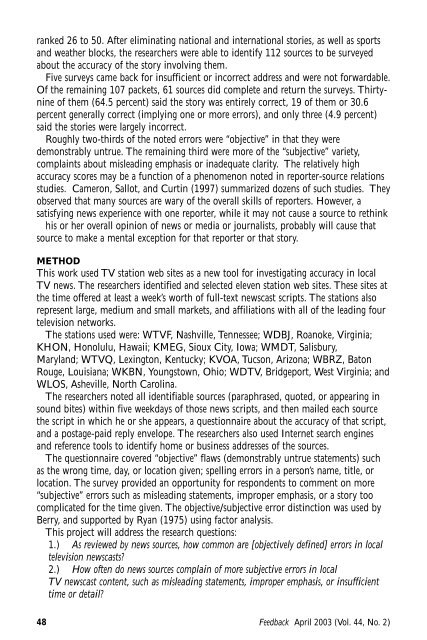APRILFeedback
Feedback April 2003 (Vol. 44, No. 2) - Broadcast Education ...
Feedback April 2003 (Vol. 44, No. 2) - Broadcast Education ...
- No tags were found...
Create successful ePaper yourself
Turn your PDF publications into a flip-book with our unique Google optimized e-Paper software.
anked 26 to 50. After eliminating national and international stories, as well as sportsand weather blocks, the researchers were able to identify 112 sources to be surveyedabout the accuracy of the story involving them.Five surveys came back for insufficient or incorrect address and were not forwardable.Of the remaining 107 packets, 61 sources did complete and return the surveys. Thirtynineof them (64.5 percent) said the story was entirely correct, 19 of them or 30.6percent generally correct (implying one or more errors), and only three (4.9 percent)said the stories were largely incorrect.Roughly two-thirds of the noted errors were “objective” in that they weredemonstrably untrue. The remaining third were more of the “subjective” variety,complaints about misleading emphasis or inadequate clarity. The relatively highaccuracy scores may be a function of a phenomenon noted in reporter-source relationsstudies. Cameron, Sallot, and Curtin (1997) summarized dozens of such studies. Theyobserved that many sources are wary of the overall skills of reporters. However, asatisfying news experience with one reporter, while it may not cause a source to rethinkhis or her overall opinion of news or media or journalists, probably will cause thatsource to make a mental exception for that reporter or that story.METHODThis work used TV station web sites as a new tool for investigating accuracy in localTV news. The researchers identified and selected eleven station web sites. These sites atthe time offered at least a week’s worth of full-text newscast scripts. The stations alsorepresent large, medium and small markets, and affiliations with all of the leading fourtelevision networks.The stations used were: WTVF, Nashville, Tennessee; WDBJ, Roanoke, Virginia;KHON, Honolulu, Hawaii; KMEG, Sioux City, Iowa; WMDT, Salisbury,Maryland; WTVQ, Lexington, Kentucky; KVOA, Tucson, Arizona; WBRZ, BatonRouge, Louisiana; WKBN, Youngstown, Ohio; WDTV, Bridgeport, West Virginia; andWLOS, Asheville, North Carolina.The researchers noted all identifiable sources (paraphrased, quoted, or appearing insound bites) within five weekdays of those news scripts, and then mailed each sourcethe script in which he or she appears, a questionnaire about the accuracy of that script,and a postage-paid reply envelope. The researchers also used Internet search enginesand reference tools to identify home or business addresses of the sources.The questionnaire covered “objective” flaws (demonstrably untrue statements) suchas the wrong time, day, or location given; spelling errors in a person’s name, title, orlocation. The survey provided an opportunity for respondents to comment on more“subjective” errors such as misleading statements, improper emphasis, or a story toocomplicated for the time given. The objective/subjective error distinction was used byBerry, and supported by Ryan (1975) using factor analysis.This project will address the research questions:1.) As reviewed by news sources, how common are [objectively defined] errors in localtelevision newscasts?2.) How often do news sources complain of more subjective errors in localTV newscast content, such as misleading statements, improper emphasis, or insufficienttime or detail?48Feedback April 2003 (Vol. 44, No. 2)
















